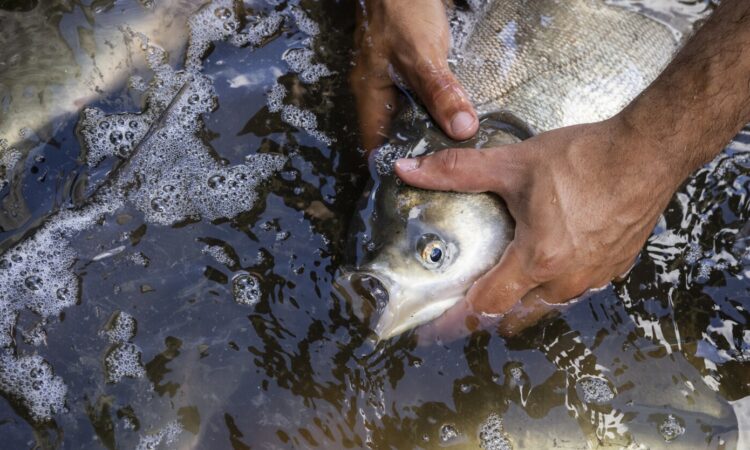
This coverage is made possible through a partnership between WBEZ and Grist, a nonprofit environmental media organization.
The Silver carp is big, unwieldy, and requires Joe Greendyk use both hands to measure it before tossing the fish overboard into the Illinois River.
The nearly 2-foot-long aquatic menace, which now overruns the river, has become the target of a state-run monitoring program to rein in its exploding numbers.
“They’re pretty slimy and pretty strong,” Greendyk says with his hands caked in fish slime. He’s a seasonal field researcher with the Illinois Natural History Survey. “So if you don’t grip them right, they’re pretty hard to control.”
For decades, local, state and federal officials have worried the carp could bypass Chicago and breach the Great Lakes, possibly reducing populations of native species that locals like to fish. The feared spread could wreak havoc on the world’s largest freshwater ecosystem and the multibillion-dollar tourism, boating and fishing industries that rely on it. Carp, which can out-eat and outgrow native fish, can also leap out of the water and startle boaters.
The fight to keep the carp under control and out of the Great Lakes may be getting easier. Last week, Illinois announced it had acquired land needed to move forward with a $1.15 billion barricade aimed at keeping the voracious Asian carp from entering the channel that connects the Mississippi River Basin with the Great Lakes.
The barricade, called the Brandon Road Interbasin Project, is an underwater defense system long hailed as the solution to the carp problem.
Designed by the U.S. Army Corps of Engineers, it’s slated to be built in the Des Plaines River, which connects the Illinois River to Chicago’s shipping canal near suburban Joliet. The billion dollar lock and dam upgrade will deploy a bubble wall, acoustic blasts, an electric barrier and a flushing mechanism to keep the carp from passing through.
Last week, Illinois officials announced they had reached a deal on Sept. 30 for the two small upland parcels totaling 2.75 acres required for the project. The donation may, however, end up costing Illinois taxpayers.
WBEZ and Grist have previously revealed longstanding concerns from state officials over contamination at the site caused by burning coal. Pritzker cited concerns about the cost of cleaning up the toxic mess in a 2024 letter to the Army Corps.
“It would be irresponsible to write a blank check to the Corps of Engineers or any other project manager without having a better understanding of what we’re agreeing to for the long term,” Pritzker’s spokesperson said in a statement at the time.
The Illinois Department of Natural Resources confirmed that state officials are currently developing a plan to investigate the site and are reviewing whether any additional land is needed.
Despite these concerns, regional leaders are pushing forward the necessary funding. Earlier this month, Pritzker joined six other Great Lakes governors in submitting a letter to Congress, calling the project a “national priority” and urging lawmakers to provide full federal financing.
The invasive carp — a family of fish which also includes the Bighead carp, Black carp and Grass Carp — first turned up in the Mississippi River about 50 years ago. Experts say fish began overwhelming the waterway after escaping Arkansas fish farms, where they were imported to help limit algae and weed growth. In the intervening years, the fish expanded their range throughout the river and its tributaries — beginning to dominate the Illinois River in the 1990s.
From the back of the carp sampling boat where Greendyk grabbed the slimy fish, Michael Spear, a quantitative ecologist with the Illinois Natural History Survey, said the carp populations weren’t as high in the northern stretch of the river as they are further downstream.
“But still, we should see some action,” he said.
Back in 2019, the INHS partnered with the Illinois Department of Natural Resources to establish a program to track the relative abundance of the carp up and down the Illinois River. As part of the program, crews of ecologists catch and track the health of the carp and native fish every year between June and October.
The data helps the state stay ahead of the carp. If populations are surging in one stretch of the river, Illinois officials can adapt their main form of carp control: paying commercial fishermen for targeted catches, including an extra 10 cents per pound of carp.
“We’re making an increasingly large dent in the population, according to these data,” Spear said. “That incentive seems to be paying off.”
He pointed to the area near Starved Rock State, one of the northernmost stretches of the more than 270-mile-long river, where he has noted drastic declines in the carp over the last five years. The Illinois Department of Natural Resources didn’t say exactly how much carp populations have declined.
Spear watched from the back of the boat as Greendyk and the rest of the crew wrapped up their sampling work for the day. While the data is promising, he said nobody wants to find out what happens if the carp ever make it past Chicago.
“The carp may not be in some of these other Great Lakes states,” Spear said. “But there’s a lot of attention from those states, because if they get into the Great Lakes, it’s going to become a much more regional problem.”







